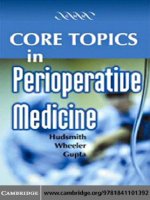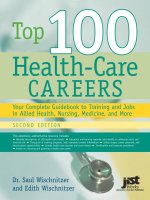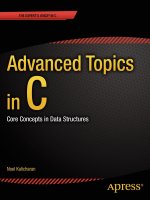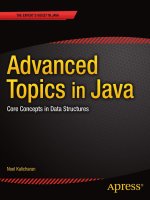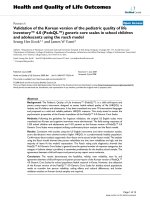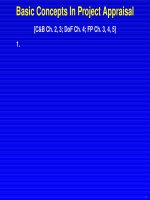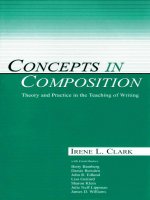Sport medicine essentials core concepts in athletic training and fitness instruction
Bạn đang xem bản rút gọn của tài liệu. Xem và tải ngay bản đầy đủ của tài liệu tại đây (26.32 MB, 737 trang )
Sports Medicine
Essentials
Core Concepts in Athletic Training & Fitness Instruction
2nd Edition
DEDICATION
To my four blondes:
Becki, my incredible wife, who allows me
to chase and accomplish my dreams;
Ryann, my oldest daughter, who was my steady
companion on the sideline for many years;
Sydney, my youngest daughter, whose constant vision
of what is real and what is not has kept me in line;
and my late mother—the ultimate teacher.
Sports Medicine
Essentials
Core Concepts in Athletic Training
& Fitness Instruction
2nd Edition
by Jim Clover, MEd, ATC, PTA
Australia
Canada
Mexico
Singapore
Spain
United Kingdom
United States
Sports Medicine Essentials: Core Concepts in Athletic Training & Fitness Instruction, 2nd Edition
By Jim Clover
Vice President, Health Care Business
Unit:
William Brottmiller
Director of Learning Solutions:
Matthew Kane
Managing Editor:
Marah Bellegarde
Acquisitions Editor:
Matthew Seeley
Printed in the United States of America
1 2 3 4 5 6 7 8 XXX 11 10 09 08 07
Or find us on the World Wide Web at
Marketing Director:
Jennifer McAvey
Production Director:
Carolyn Miller
Marketing Channel Manager:
Michele McTighe
Content Project Manager:
Kenneth McGrath
Technology Director:
Laurie Davis
Senior Art Director:
Jack Pendleton
Technology Project Coordinator:
Carolyn Fox
ALL RIGHTS RESERVED. No part of this
work covered by the copyright hereon may be
reproduced or used in any form or by any
means—graphic, electronic, or mechanical,
including photocopying, recording, taping,
Web distribution or information storage and
retrieval systems—without the written permission of the publisher.
For permission to use material from this
text or product, contact us by
Tel (800) 730-2214
Fax (800) 730-2215
Library of Congress Cataloging-in-Publication
Data
Clover, Jim.
Sports medicine essentials : core concepts
in athletic training & fitness instruction / by
Jim Clover.—2nd ed.
p. ; cm.
Includes bibliographical references and
index.
ISBN-13: 978-1-4018-6185-8
ISBN-10: 1-4018-6185-7
1. Sports medicine. 2. Physical fitness. I. Title.
[DNLM: 1. Sports Medicine. QT 261 C647s
2007]
RC1210.C5569 2007
617.1’027—dc22
2007010385
Notice to the Reader
Publisher does not warrant or guarantee any of the products described herein or perform any independent analysis in connection with any of
the product information contained herein. Publisher does not assume, and expressly disclaims, any obligation to obtain and include information
other than that provided to it by the manufacturer.
The reader is expressly warned to consider and adopt all safety precautions that might be indicated by the activities described herein
and to avoid all potential hazards. By following the instructions contained herein, the reader willingly assumes all risks in connection with such
instructions.
The publisher makes no representations or warranties of any kind, including but not limited to, the warranties of fitness for particular
purpose or merchantability, nor are any such representations implied with respect to the material set forth herein, and the publisher takes no
responsibility with respect to such material. The publisher shall not be liable for any special, consequential, or exemplary damages resulting, in
whole or part, from the reader’s use of, or reliance upon, this material.
Contents
Preface xx
How to Use This Book xxiv
CHAPTER 1
Careers in Sports Medicine
Objectives / 1
Key Terms / 2
Sports Medicine: The Circle of Care / 2
Career Opportunities / 3
Personal Attributes Required for a Career in
Sports Medicine / 6
Thinking It Through / 8
Chapter Summary / 8
Student Enrichment Activities / 9
CHAPTER 2
Athletic Training
Objectives / 10
Key Terms / 11
What Is Athletic Training? / 11
The Sports Medicine Team / 11
What Does It Take to Be an Athletic Trainer? / 15
Characteristics / 16
Athletic Training Curricula (From the NATABOC
Web Site) / 16
Athletic Training Practice Domains / 16
Employers of Athletic Training Services / 17
Ideal Practices for Athletic Trainers as
Physician Extenders / 17
Other Related Skills / 17
The Team Physician / 11
The Certified Athletic Trainer (ATC®) / 12
The Coach / 13
The Athlete / 14
The Athletes’ Parents or Guardian / 14
The School Administration / 15
The Community Health Facilities / 15
The Responsibilities of an Athletic Trainer / 17
v
vi
CONTENTS
Academic Requirements and Professional
Certification / 19
®
The ATC Credential / 20
The Athletic Training Student (ATS) / 21
The Athletic Training Student Aide / 22
Record Keeping / 23
Special Instructions / 28
Chapter Summary / 29
Student Enrichment Activities / 30
CHAPTER 3
Strength and Conditioning Specialist
Objectives / 32
Key Terms / 33
What Does Physical Fitness Mean? / 33
Are You Fit for the Job? / 34
Educational Requirements / 35
Educational Materials / 36
Evaluating Physical Fitness / 40
Factors to Consider When Developing
a Fitness Program / 42
Skill Factors in Physical Fitness / 42
Health Factors in Physical Fitness / 42
Motivating Clients / 44
Working With Your Clients / 36
Helping Your Clients Set Goals / 44
Positive Verbal Cues / 48
Music as a Motivator / 48
The Appearance of the Facility / 48
Are the Clients Having Fun? / 48
Establishing Rapport / 38
Establishing Good Communication / 38
The First Sessions With Your Client / 39
Make Advance Contact / 39
At the First and Every Meeting / 39
Be on Time / 39
Your Appearance / 39
Allow Extra Time for the First Session / 39
Be Organized / 40
The Latest Trends / 49
Thinking It Through / 50
Chapter Summary / 50
Student Enrichment Activities / 51
CHAPTER 4
Ethical and Legal Considerations
Objectives / 53
Key Terms / 54
Introduction / 54
Team Ethics / 55
The Team Physician / 55
The Athletic Trainer / 56
The Coach / 56
The Athlete / 57
The Athletes’ Parents/Guardian / 57
The Administration / 57
Expected Conduct for Sports Medicine Professionals
and Athletes / 58
Appropriate Responses to Breaches of Ethical
and Regulatory Codes / 64
CONTENTS
Legal Responsibilities / 65
Thinking It Through / 67
Thinking It Through / 68
The Rights of the Patient / 69
Risk Management in Sports / 71
Thinking It Through / 75
Chapter Summary / 76
Student Enrichment Activities / 77
CHAPTER 5
Physical Fitness Assessment
Objectives / 79
Key Terms / 80
Fitness Evaluation / 80
Muscular Endurance Evaluations / 81
Bent-Leg Sit-Ups / 81
Push-Ups / 82
Modified Push-Ups / 83
Bench Jump or Step / 84
Determining the Resting Heart Rate / 89
The Pulse Recovery Step Test / 89
Body Composition / 90
Recommended Ranges of Body Fat / 91
Body Composition and Athletes / 91
Determining Muscle Gain or Loss / 94
Recording / 96
Special Considerations / 96
Musculoskeletal Capabilities and Limitations / 96
Other Physical and Medical Conditions / 99
Flexibility Evaluations / 86
Sit and Reach (Trunk Flexion) / 86
Back Bend (Trunk Extension) / 87
Evaluating Cardiovascular Endurance / 87
Measuring the Heart Rate / 89
Thinking It Through / 100
Chapter Summary / 100
Student Enrichment Activities / 101
CHAPTER 6
Nutrition and Weight Management
Objectives / 103
Key Terms / 104
The Healthy Diet / 104
Carbohydrates / 105
Athletes and Carbohydrates / 105
Protein / 106
Athletes and Protein / 107
Fat / 108
Fats and Cholesterol / 108
Athletes and Fat / 109
Fiber / 109
Athletes and Fiber / 110
Vitamins / 111
Athletes and Vitamins / 111
Minerals / 112
Athletes and Minerals / 112
Water / 112
Athletes and Water / 112
Dietary Reference Intakes / 113
The Food Guide Pyramid / 114
The Well-Balanced Diet / 119
vii
viii CONTENTS
Using Nutrition Fact Labels to Make Wise Food
Choices / 120
Daily Values and Dietary Reference Values / 121
A Word About “Fast Food” / 121
Weight Control and Energy Balance / 122
Body Composition and “True Weight” / 123
Losing Weight / 123
Gaining Weight / 127
Nutritional Supplements and Dietary Fads / 127
Steroids / 131
Creatine / 133
Pre-Exercise Meals / 133
Recovery / 134
Eating Disorders / 134
Bulimia Nervosa / 135
Anorexia Nervosa / 135
The Psychological Consequences of Eating
Disorders / 136
Thinking It Through / 136
Chapter Summary / 137
Student Enrichment Activities / 138
A Word of Caution / 130
Ergogenic Aids / 131
CHAPTER 7
Physical Conditioning
Objectives / 140
Key Terms / 141
Introduction / 141
Basic Principles of Weight Training / 143
The Overload Principle / 143
The Variation Principle / 144
The Specificity Principle / 144
Exercising Muscles Correctly / 144
Flexibility Exercises / 147
Lateral Neck Stretch / 148
Chest Stretch / 148
Anterior Deltoid Stretch / 148
Posterior Deltoid Stretch / 149
Triceps Stretch / 149
Wrist Stretch / 149
Back Extension/Abdominals Stretch / 150
Low Back Stretch (One Knee) / 150
Low Back Stretch (Both Knees) / 150
Cat Stretch (Upper and Mid-Back) / 151
Hip Flexor Stretch / 151
Hip/Trunk/Tensor Fasciae Latae (TFL)
Stretch / 152
Groin Stretch (Butterfly) / 152
Lying Hamstring Stretch / 152
Standing Hamstring Stretch / 153
Standing Quadriceps Stretch / 153
Gastrocnemius Stretch / 153
Soleus Stretch / 154
Strengthening Exercises / 154
Isometric Exercises / 154
Isotonic Exercises / 155
Isokinetic Exercises / 156
Strengthening Exercises by Muscle Group / 157
Chest/Pectoralis Strengthening / 158
Incline Bench Press—Free Weights / 158
Bench Press—Free Weights / 158
Chest Fly—Guided Weights / 159
Incline Bench Press—Guided Weights with Variable
Resistance / 159
Deltoid Strengthening / 159
Bent-Over Row—Free Weights / 160
Military Press—Free Weights / 160
Military Press—Guided Weights / 160
Deltoid Raise—Guided Weights / 161
Latissimus Dorsi Strengthening / 161
Lat Pulldown—Guided Weights / 161
Rhomboid Strengthening / 162
Bent-Over Row—Free Weights / 162
Seated Row—Guided Weights / 162
CONTENTS
Triceps Strengthening / 162
Quadriceps and Gluteal Strengthening / 170
Chair Dip—Body Weight / 162
Triceps Curl—Free Weights / 163
Triceps Curl—Guided Weights / 163
Biceps Strengthening / 163
Biceps Curl—Guided Weights / 164
Biceps Curl—Free Weights (Dumbbell) / 164
Biceps Curl—Free Weights (Curl Bar) / 164
Trapezoid Strengthening / 165
Leg Press—Guided Weights / 170
Hack Squat Using the Leg Press—Free Weights / 170
Squat—Free Weights / 171
Hamstring Strengthening / 171
Leg Curl—Guided Weights / 172
Gastrocnemius and Soleus Strengthening / 172
Heel Raise—Guided Weights / 172
Cardiovascular Exercises / 173
Upright Row—Free Weights / 165
Power Walking / 173
Running and Jogging / 174
Aerobics and Step Classes / 174
Bicycling / 175
Rowing Machines / 175
Ski Machines / 176
Stair Climbers / 176
Stair-Steppers / 176
Elliptical Trainers / 177
Upper-Body Ergometers (UBEs) / 177
Trunk Strengthening / 165
Sit-Up (Upper Abdominals/Trunk Flexion) / 166
Leg Curl (Lower Abdominals) / 166
Internal and External Rotational
Trunk Curls / 166
Trunk Extension—Guided Weights / 167
Trunk Extension—Body Weight / 168
Hip Strengthening / 168
Hip Adduction—Guided Weights / 168
Hip Abduction—Guided Weights / 169
Hip Flexion—Guided Weights / 169
Hip Extension—Guided Weights / 170
Thinking It Through / 178
Chapter Summary / 179
Student Enrichment Activities / 180
CHAPTER 8
Designing a Conditioning Program
Objectives / 182
Key Terms / 183
Individual Training Programs / 183
Know Your Client / 183
Goals / 184
Time Schedules / 185
Existing Habits and Preferences / 188
Designing the Program / 189
Mode / 189
Intensity and Capacity / 190
Duration / 191
Frequency / 192
Special Considerations / 193
Fun / 194
Schedule Time for Rest and Sleep / 195
Safely Increasing and Maintaining
Fitness Levels / 195
Progression / 195
Variety / 196
Basic Walking and Jogging Programs / 196
A Sample Introductory Program / 199
Taking Responsibility for Our Health / 205
Thinking It Through / 206
Chapter Summary / 206
Student Enrichment Activities / 208
ix
x
CONTENTS
CHAPTER 9
Emergency Preparedness and Assessment
Objectives / 210
Key Terms / 211
Emergencies Are Inevitable / 211
The Importance of Good
Observational Skills / 212
Plan for Emergency Action / 212
Implementing Emergency Procedures / 215
The Primary Survey / 216
Thinking It Through / 219
The Secondary Survey / 220
HOPS / 227
Body Planes and Directional Terms / 228
Movement of the Athlete / 230
Chapter Summary / 230
Student Enrichment Activities / 231
Airway / 216
Breathing / 217
Circulation / 219
Chapter 10
Assembling the First Aid Kits and Equipment Bags
Objectives / 233
Key Terms / 234
Basic First Aid Kits / 234
The Basic First Aid Kit / 234
The Forms / 236
The Personal Kit / 242
First Aid Kits for Transport Vehicles / 242
Enhancing the Basic Kit / 242
Carrying Over-the-Counter Medications / 243
Athlete-Specific Kit / 243
Sport-Specific Kit Upgrades / 244
Football Field Kit / 246
Helmet Kit / 247
Shoulder Pad Kit / 248
Football Tape Bag / 248
Injury Pad Bag / 249
The Physician’s Kit / 250
Away-Game Items / 252
Home- and Away-Game Field Setup / 253
Thinking It Through / 254
Chapter Summary / 254
Student Enrichment Activities / 255
CONTENTS
CHAPTER 11
Infection Control
Objectives / 256
Key Terms / 257
The Chain of Infection / 257
Breaking the Chain of Infection / 258
Clean Technique and Sterile Technique / 259
Handwashing—The Key to
Clean Technique / 260
Using Gloves to Protect Yourself and Others / 262
Removing Blood-Stained Clothing / 266
Avoiding Contaminated Sharps / 266
The Risks—Hepatitis and AIDS / 267
Thinking It Through / 269
Chapter Summary / 269
Student Enrichment Activities / 270
CHAPTER 12
Vital Signs Assessment
Objectives / 272
Key Terms / 273
The Vital Signs / 273
Pulse / 273
Respiration / 278
Blood Pressure / 281
Thinking It Through / 285
Temperature / 285
Weight and Height / 289
Chapter Summary / 292
Student Enrichment Activities / 293
CHAPTER 13
Basic Life Support
Objectives / 294
Key Terms / 295
Introduction to Lifesaving Procedures / 295
Cardiopulmonary Resuscitation / 295
Sudden Cardiac Arrest / 296
Chain of Survival / 296
Automated External Defibrillator (AED) / 299
Basic AED Operation / 299
Foreign Body Airway Obstructions / 300
The Log Roll / 302
Thinking It Through / 303
Chapter Summary / 304
Student Enrichment Activities / 305
xi
xii CONTENTS
CHAPTER 14
Injuries to the Tissues
Objectives / 306
Key Terms / 307
Injuries Are Inevitable / 307
Cells and Tissues / 309
Cells / 309
Tissues / 310
Controlling Bleeding / 311
General Principles of Wound Care / 313
Dressing and Bandages / 313
Superficial Injuries to the Soft Tissues / 315
Abrasions / 315
Lacerations / 316
Puncture Wounds / 317
Incisions / 317
Avulsions / 318
Calluses / 319
Blisters / 319
Bites and Stings / 320
Skin Infections and Other Dermatological
Conditions / 321
Hematomas / 322
Contusions / 323
The Muscular System / 325
Injuries to the Muscle Tissues / 329
Muscle Strain / 329
Myositis Ossificans / 330
Tendonitis / 331
The Joints / 331
Injuries to the Joints / 333
Ligament or Capsular Sprains / 333
Dislocations and Subluxations / 335
Synovitis and Bursitis / 336
The Skeletal System / 336
Injuries to the Skeletal System / 338
Fractures / 338
Thinking It Through / 341
Chapter Summary / 341
Student Enrichment Activities / 343
CHAPTER 15
Injuries to the Head and Spine
Objectives / 346
Key Terms / 347
Introduction / 347
The Head: An Overview / 347
The Nervous System / 350
The Central Nervous System / 351
The Peripheral Nervous System / 353
Treating a Downed Athlete: A Review / 355
Injuries to the Brain / 357
Concussions / 359
Injuries to the Ear / 362
Cauliflower Ear / 363
Otitis Externa (Swimmer’s Ear) / 363
Rupture of the Tympanic Membrane / 364
Foreign Bodies in the Ear / 364
Injuries to the Eye / 364
Contusions / 366
Corneal Abrasions or Lacerations / 366
Retinal Detachment / 367
Foreign Bodies and Embedded Objects / 367
CONTENTS
Fractures—Orbital Roof and Blowout / 368
Conjunctivitis / 368
Sty / 369
Hyphema / 369
Ruptured Globe / 369
Contact Lens Complications / 370
The Spine / 375
Injuries to the Spine / 377
Contusions / 377
Brachial Plexus Injuries / 377
Abnormal Curvatures of the Spine / 378
Muscle Spasms / 379
Back Sprains / 379
Back Strains / 380
Fractures and Dislocations / 380
Intervertebral Disc Herniation / 381
Spondylolysis and Spondylolisthesis / 382
Injuries to the Nose / 370
Nosebleeds (Epistaxis) / 371
Nasal Septal Deviation / 372
Nasal Septal Hematoma / 372
Nasal Fractures / 373
Injuries to the Mouth and Jaw / 373
Temporomandibular Joint (TMJ) Dislocation / 374
Jaw Fractures / 374
Dislocations and Fractures of the Teeth / 374
Exposed Nerve / 375
xiii
Thinking It Through / 383
Chapter Summary / 383
Student Enrichment Activities / 385
CHAPTER 16
Injuries to the Upper Extremities
Objectives / 387
Key Terms / 388
Introduction / 388
The Shoulder Complex / 388
Assessing Shoulder Injuries / 394
General Range-of-Motion (ROM) Evaluations for
the Shoulder / 394
Manual Muscle Tests for the Shoulder / 396
Injuries to the Shoulder / 398
Fractures / 398
Dislocation and Subluxations / 399
Contusions / 400
Sprains / 401
Strains / 404
Impingement / 404
Tendonitis / 406
Synovitis and Bursitis / 406
The Elbow and Forearm / 407
Assessing Elbow and Forearm Injuries / 409
General Range-of-Motion Evaluations for
the Elbow / 409
Manual Muscle Tests for the Elbow / 410
Injuries to the Elbow and Arm / 412
Fractures / 412
Dislocations and Subluxations / 412
Contusions / 412
Sprains / 412
Impingement / 413
Synovitis and Bursitis / 414
Biceps Brachii Rupture / 414
Epicondylitis / 415
Volkmann’s Contracture / 416
The Wrist and Hand / 416
Assessing Wrist and Hand Injuries / 417
General Range-of-Motion Evaluations for the Wrist
and Hand / 417
Manual Muscle Tests for the Wrist and Hand / 418
Injuries to the Wrist and Hand / 421
Fractures / 421
Dislocations and Subluxations / 421
Contusions / 421
Sprains / 421
Impingement / 421
Tendonitis / 423
xiv CONTENTS
Ganglion Cyst of the Wrist / 423
Mallet Finger / 424
Buttonhole (Boutonniere) Deformity / 424
Thinking It Through / 425
Chapter Summary / 425
Student Enrichment Activities / 427
CHAPTER 17
Injuries to the Chest and Abdomen
Objectives / 429
Key Terms / 430
The Chest / 430
Pulmonary Contusion / 443
Blows to the Solar Plexus / 443
Chest Contusions / 444
Side Stitches / 444
The Heart / 430
The Circulatory System / 431
Blood and Blood Cells / 432
Blood Vessels / 433
The Coronary Circulatory Path / 434
The Lungs / 435
The Ribs / 436
The Respiratory System / 436
The Breathing Process / 438
Injuries to the Chest / 440
Myocardial Contusions and Aortic Ruptures / 440
Fractures / 440
Pneumothorax / 441
Hemothorax / 441
Hyperventilation / 442
Flail Chest / 442
The Abdomen: An Overview / 445
The Spleen / 446
The Liver / 447
The Kidney / 447
The Bladder / 447
The Pancreas / 448
Injuries to the Organs of the Abdomen / 448
Contusions / 449
Ruptures and Lacerations / 449
Shock / 449
Hernias / 450
Thinking It Through / 450
Chapter Summary / 451
Student Enrichment Activities / 452
CHAPTER 18
Injuries to the Pelvis and Lower Extremities
Objectives / 455
Key Terms / 456
Introduction / 456
The Pelvis / 456
Injuries to the Pelvic Region / 458
Fractures / 458
Strains / 459
Contusions / 459
The Hip and Thigh / 460
Assessing Hip Injuries / 462
Range-of-Motion (ROM) Evaluations for
the Hip / 462
Manual Muscle Tests for the Hip / 464
Injuries to the Hip and Thigh / 467
Fractures / 467
Dislocations and Subluxations / 468
CONTENTS
Contusions / 469
Sprains / 469
Strains / 470
Bursitis and Synovitis / 470
The Knee and Lower Leg / 471
Assessing Knee Injuries / 473
Range-of-Motion Evaluations for the Knee / 473
Manual Muscle Tests for the Knee / 474
Injuries to the Knee and Lower Leg / 475
Fractures / 475
Dislocations and Subluxations / 476
Contusions / 476
Sprains / 477
Strains / 480
Tendon Ruptures / 481
Tears of the Meniscus / 481
Tendonitis / 483
Bursitis / 484
Osgood-Schlatter Disease / 484
Chondromalacia Patellae / 485
Shin Splints (Medial Tibial Stress Syndrome) / 486
Anterior Compartment Syndrome / 486
The Ankle and Foot / 487
Assessing Ankle and Foot Injuries / 489
Range-of-Motion Evaluations for the
Ankle/Foot / 489
Manual Muscle Tests for the Ankle/Foot / 490
Injuries to the Ankle and Foot / 491
Fractures / 491
Dislocations and Subluxations / 492
Contusions / 492
Sprains / 492
Tendon Ruptures / 493
Tendonitis / 494
Bursitis and Synovitis / 494
Ingrown Toenail / 495
Athlete’s Foot / 495
Plantar Fasciitis / 496
Thinking It Through / 496
Chapter Summary / 497
Student Enrichment Activities / 498
CHAPTER 19
Environmental Conditions
Objectives / 500
Key Terms / 501
Introduction / 501
Environmental Conditions Affecting Athletes / 501
Environmental Heat Stress / 502
Sunburn / 504
Heat-Related Illness / 505
Heat Cramps / 505
Heat Exhaustion / 506
Heatstroke / 507
Guidelines for Preventing Heat-Related
Disorders / 507
Environmental Cold Stress / 511
Hypothermia / 511
Frostbite / 512
Lightning / 513
Thinking It Through / 514
Chapter Summary / 514
Student Enrichment Activities / 516
xv
xvi CONTENTS
CHAPTER 20
Medical Conditions
Objectives / 518
Key Terms / 519
Introduction / 519
Medical Conditions Affecting Athletes / 519
Diabetes Mellitus / 519
Hypoglycemia and Insulin Shock / 521
Asthma / 521
Seizure Disorders (Epilepsy) / 522
Appendicitis / 523
Genetic Heart Conditions / 523
Common Viruses / 524
Thinking It Through / 525
Chapter Summary / 525
Student Enrichment Activities / 526
CHAPTER 21
Taping and Wrapping
Objectives / 527
Key Terms / 528
Adhesive Tape in the Prevention and Treatment
of Athletic Injuries / 528
Taping Guidelines / 529
The Need for Quality in Athletic
Adhesive Tapes / 529
Use and Storage of Athletic Tape / 530
The Purpose of Taping / 530
Taping Pitfalls to Avoid / 531
Basic Ankle Strapping / 532
Combination Elastic and Nonelastic Tape Ankle
Strapping / 535
Lower Tibia Taping / 536
Turf Toe Taping / 536
Arch Taping / 537
Basic Knee Strapping / 539
Achilles Tendon Taping / 544
Elbow Taping / 545
Wrist Strapping / 546
Thumb Taping / 547
Finger Taping / 548
Restriction of Thumb Flexion, Extension, and
Abduction / 549
Basic Ankle Wrapping / 550
Calf and Knee Wrapping / 551
Gastrocnemius (Calf) Wrap / 551
Knee Wrap / 552
Thigh, Groin, and Back Wrapping / 552
Hamstring/Quadriceps Wrap / 552
Groin Wrap / 552
Back Wrap / 553
Elbow, Hand, and Thumb Wrapping / 553
Elbow Wrap / 553
Hand Wrap / 553
Thumb Wrap / 553
Moleskin / 553
Taping Supplies / 554
Thinking It Through / 555
Chapter Summary / 556
Student Enrichment Activities / 557
CONTENTS
CHAPTER 22
Return To Play
Objectives / 559
Key Terms / 560
Who Makes the Decision? / 560
Physical Considerations / 561
General Assessment Procedures / 562
Assessing Return-to-Play Potential for Athletes with
Upper-Extremity Injuries / 563
Assessing Return-to-Play Potential for Athletes with
Lower-Extremity Injuries / 564
Assessing Return-to-Play Potential for Athletes with
Injuries to the Back or Trunk / 565
Follow-up Procedures / 566
Psychological Considerations / 567
Denial / 568
Anger / 568
Bargaining / 569
Depression / 570
Acceptance / 570
Understanding and Responding to Abnormal
Behaviors / 571
Thinking It Through / 572
Chapter Summary / 573
Student Enrichment Activities / 574
CHAPTER 23
Therapeutic Modalities
Objectives / 576
Key Terms / 577
Therapeutic Modalities and Their Use in
Rehabilitation / 577
Legal Implications Associated with the Use of
Therapeutic Modalities / 577
The Use of Modalities / 578
Choosing a Modality / 578
Methods of Heat or Cold Transfer / 579
Cryotherapy / 579
Guidelines for Cryotherapy / 580
Ice Packs / 580
Ice Massage / 581
Vapo-Coolant Sprays / 582
Ice Water Immersion / 583
Whirlpool Baths / 584
Thermotherapy / 585
Guidelines for Thermotherapy / 586
Moist Heat Packs / 586
Fluidotherapy / 587
Paraffin Bath / 588
Electrical Modalities / 589
Guidelines for Electrical Modalities / 590
Ultrasound Therapy / 590
Electrical Muscle Stimulation (EMS) / 592
Galvanic Stimulation / 592
Interferential Stimulation (IFS) / 593
Iontophoresis / 594
Transcutaneous Electrical Nerve Stimulation
(TENS) / 594
Diathermy / 595
Mechanical Modalities / 595
Guidelines for Mechanical Modalities / 595
Intermittent Compression / 595
Traction / 596
Massage Therapy / 597
Thinking It Through / 601
Chapter Summary / 602
Student Enrichment Activities / 603
xvii
xviii CONTENTS
CHAPTER 24
Physical Rehabilitation
Objectives / 606
Key Terms / 607
The Goals of Rehabilitation / 607
The Rehabilitation Team / 607
Physician / 608
Physical Therapist / 608
Athletic Trainer / 608
Strength and Conditioning Specialist / 608
Physical Therapist Assistant / 609
Physical Therapy Aide / 609
The Patient’s Family / 609
The Teammates / 609
The Patient / 609
The Rehabilitation Environment / 610
Patient Safety / 610
Patient Needs / 611
Patient Comfort / 611
Staff Conduct / 613
SOAP Notes in Documentation / 625
Subjective Findings / 625
Objective Findings / 625
Assessment / 627
Plan / 627
Outcomes / 628
The Phases of Physical Rehabilitation / 628
Safety Guidelines for All Phases of
Rehabilitation / 629
Phase I: Control Inflammation / 629
Phase I Plan / 630
Phase II: Repair / 631
Phase II Plan / 632
Phase III: Remodel / 633
Phase III Plan / 633
The Importance of Patient Education / 635
Activities of Daily Living (ADLs) / 636
Nutritional Needs / 637
Crutches / 637
The First Session / 614
Patient History / 614
Motivating the Patient / 618
Posture and Joint Assessment / 619
Thinking It Through / 639
Chapter Summary / 639
Student Enrichment Activities / 641
Posture Assessment / 619
Joint Measurements / 621
CHAPTER 25
The Selling Point: Promoting Fitness Products and Services
Objectives / 643
Key Terms / 644
The Health Professional as a Salesperson / 644
Types of Sales Presentations / 645
Face-to-Face Meetings / 645
Internet-Based Presentations / 645
Telephone Sales / 646
Educational Materials for Handouts, Trade Shows,
and Direct Mail / 646
Mass Media Promotions (Television/
Radio/Print) / 647
CONTENTS
Making a Good First Impression / 647
Meeting Someone in Person / 647
Using the Telephone / 648
Written Introductions / 649
Creating Effective Written Introductions / 649
General Guidelines for Correspondence / 649
Developing the Resumé / 650
Writing a Cover Letter / 652
Techniques for Interviews and Other Face-to-Face
Presentations / 652
Promotional Materials / 656
Plan for Success / 658
The Employment Plan / 659
The Business Plan / 661
Taking Action (Playing the Option) / 663
Continuing Your Education / 663
Thinking It Through / 665
Chapter Summary / 665
Student Enrichment Activities / 667
xix
Preface
the knowledge and skills needed in those careers.
The chapters can be used in sequence, or because
of the independent strength of each chapter, they
can be used out of sequence. Although this
book is designed to be used as a textbook, when
the class is completed, it can easily be used as a
reference book.
Sports Medicine Essentials: Core Concepts in Athletic
Training & Fitness Instruction, 2nd Edition encompasses the fields of athletic training and fitness
instruction. It is appropriate for high school and
college level students interested in athletic training or fitness instruction.
Written by a National Athletic Trainers’
Association (NATA)-certified athletic trainer,
Sports Medicine Essentials provides students with
the skills and knowledge they need to establish a
career path in sports medicine in roles such as
athletic trainer, physical therapist, strength and
conditioning specialist, personal trainer, or medical salesperson. Topics include anatomy and
physiology, emergency preparedness, vital signs,
basic life support, treatment and prevention of
injuries, nutrition and weight control, therapeutic modalities, and physical rehabilitation.
Students in sports medicine have to be
multifaceted. All facets of sports medicine are
included within the chapters. Additionally,
Sports Medicine Essentials provides an introduction to injury evaluation, rehabilitation, fitness
evaluation, strength and conditioning, taping
and wrapping techniques, and medical sales.
The need for well-trained athletic trainers
now and in the future is substantial in high
schools as well as many other levels. With the
changes in health insurance coverage, self-knowledge in health care is also very important. The goal
of Sports Medicine Essentials is to ensure that the student is given a well-rounded view of the field of
sports medicine.
FEATURES
Each chapter begins with Objectives and Key
Terms that will help focus the student on the
concepts to be covered.
Student Enrichment Activities found at the
end of every chapter provide review questions
and activities so students can check their
comprehension.
Each chapter also contains Thinking It Through
scenarios that promote critical thinking skills that
students can apply to real-life situations.
Full-color photos and illustrations bring
authenticity to the content.
NEW TO THIS EDITION
All chapters have been revised for better readability and updated with changing information
and new photos where applicable. Listed below
are some of the highlights of those updates.
Chapter One was revised to reflect the
changes in the career path to become a certified
athletic trainer.
Chapter Two includes an updated definition of an athletic trainer to match NATA’s
description as well as new curriculum and
certification guidelines set by NATA and the
Board of Certification. In addition, Health
Insurance Portability and Accounting Act
TEXTBOOK ORGANIZATION
The book is divided into 25 chapters. The first
part of the book establishes some of the available
careers in sports medicine. Later chapters present
xx
PREFACE
(HIPAA) regulations and how they relate to athletic training and other health care professions
have been included.
Chapter Three now refers to the “strength
and conditioning specialist.”
In Chapter Four, the NATA Code of Ethics
has been updated.
Chapter Five has updated fitness charts.
Chapter Six has updated nutritional charts
based on changes to the Food Guide Pyramid
and new information on creatine, steroids, and
hydration has been included.
Chapters Seven and Eight have been updated
as needed and Chapter Nine includes updated
CPR standards.
Chapters Ten, Eleven, and Twelve include
updated first aid kits, new standards for infection control, and new blood pressure standards.
Chapter Thirteen now includes the use of an
automated external defibrillator (AED) and new
CPR standards.
Chapter Fourteen has updated Occupational
Safety and Health Administration (OSHA)
guidelines and updated wound care, and Chapter
Fifteen has new concussion guidelines.
Chapters Sixteen, Seventeen, and Eighteen have
many new illustrations and include information
on the Epstein-Barr virus.
Chapter Nineteen now includes lightning, one
of the top-three causes of weather-related deaths.
Chapter Twenty has been updated to the new
first aid standards; Chapter Twenty-One now
includes elastic wraps; and Chapter Twenty-Two
addresses managing sports injuries and determining return to play.
Chapter Twenty-Four continues to address
physical rehabilitation.
Chapter Twenty-Five has been updated to
match current sales conditions.
ALSO AVAILABLE FOR
THE STUDENT
Student Workbook to Accompany Sports Medicine
Essentials: Core Concepts in Athletic Training & Fitness
Instruction, 2nd Edition, ISBN: 1-4018-6186-5
xxi
The workbook contains Assignment Sheets,
Matching questions, True/False questions, Short
Answer questions, Word Search puzzles, and
Crossword puzzles all designed to test comprehension of chapter concepts.
ALSO AVAILABLE FOR
THE INSTRUCTOR
Electronic Classroom Manager to Accompany
Sports Medicine Essentials: Core Concepts in Athletic
Training & Fitness Instruction, 2nd Edition, ISBN:
1-4018-6187-3
This CD package contains:
* Instructor’s Manual containing tips for
class instruction including topics for
class discussion and learning activities.
Also includes answers to Thinking It
Through scenarios and answers to the
Student Enrichment Activities.
* ExamView ® Computerized Test Bank
containing over 1,200 questions. You can
use these questions to create your own
review materials or tests.
* Over 280 PowerPoint® slides correlating
to the chapters within the book. These
easily can be customized to meet your
needs.
ABOUT THE AUTHOR
Jim Clover, MEd, ATC, PTA, has been the coordinator of the SPORT Clinic in Riverside,
California for over 25 years. The SPORT Clinic is
part of Community Medical Group, a multispecialty clinic made up of orthopedic surgeons,
physical therapists, athletic trainers, a surgery
center, and a family practice department. The
SPORT Clinic reaches out to over 40 high
schools and colleges, organizing the sports medicine coverage for over 3,000 events per year.
Mr. Clover has been an instructor of a
regional occupational course “Sports Therapy
and Fitness” for over 20 years, and has taught a
xxii PREFACE
tele-course on athletic training at Riverside
Community College and University of California
Riverside and an athletic training course at
California Baptist College and Cal State San
Bernardino.
Mr. Clover is the owner of Clover Enterprise,
a corporation that provides athletic training coverage to 17 local high schools. He is also the
inventor of the “Trainer’s Angel,” the first face
mask removal tool; the inventor of the R.E.D.
Book, a book that organizes sports medicine
forms; producer of the athletic trainer’s theme
song “First to Come and Last to Leave;” author of
five sports medicine videos for Cramer Products;
past chair for the NATA District 8 Clinical
Industrial and Cooperate Committee; past chair
for the Job Development task force; District 8 representative for the NATA Foundation; a 25-year
member of NATA; District 8 and NATA recipient
of the “Most Distinguished Athletic Trainer’s
Award;” and past chair of the Riverside SPORT
Hall of Fame.
In addition, Mr. Clover has authored several
chapters of marketing books, EMP America’s
“Sports Medicine First Aid,” and numerous articles; been a speaker at numerous events; and
been an instructor for all first aid and CPR
courses taught through EMP America.
Mr. Clover is coordinator of Practical
Applications in Sports Medicine, a sports medicine conference that has been held for over
15 years, and coordinator of the Inland Empire
All-Star Football classic for over 20 years (this
event raised over $100,000 in college scholarships). He also coordinated Cramer Student
Trainer camps in Riverside, California, and was a
clinical coordinator for a sports medicine family
practice fellowship for over 10 years.
Mr. Clover can be contacted at sportclinic@
earthlinic.net.
ACKNOWLEDGEMENTS
I would like to thank the following people: Jessica
Bear, an undergraduate student at Wagner
College; Jim Winn, MED, ATC, PTA; Todd
Babcock, MS, ATC; Jim Elton, MS, ATC; Allen
Boyd, ATC; the physicians and physical therapists
at Community Medical Group and SPORT
Clinic; Ellen Coleman for her expertise in sport
nutrition; Carol Scott for her help with the editing; Jerome F. Wall, M.D. for his constant positive
guidance and expertise; and my college instructors, Billy Hill, ATC; Linda Daniels, PT, ATC; and
Mike Bordner, ATC. I also want to thank James B.
Clover, Sr., a very talented teacher; Valerie Harris,
who worked on the first edition; and my incredibly tolerant editors, Erin Curtis, Matthew Seeley,
and Nikki Lee.
REVIEWERS
The following reviewers provided valuable
feedback in the creation of this text. Their time,
comments, and attention to detail are greatly
appreciated.
Andrew E. Accardi, ATC/L, M.Ed.
Newman Central Catholic High School,
Sterling IL
Steven P. Broglio, MS, ATC
University of Georgia, Athens, GA
James Buriak, ATC
Roanoke College, Salem, VA
Dr. Lori Dewald, EdD, ATC, CHES
University of Minnesota Duluth,
Duluth, MN
Michael W. Goforth
Virginia Tech, Blacksburg, VA
Pat Graman, MA, ATC
University of Cincinnati, Cincinnati, OH
Birgid Hopkins, MS, L.ATC,
Merrimack College, North Andover, MA
Barry Meier
Riverside Community College,
Riverside, CA
Randy McGuire, M.S., ATC
Georgetown College, Georgetown, KY
Lisa T. Petruzzi, Med, VATL, ATC
Mount Vernon High School,
Alexandria, VA
Julie Rochester, MS, ATC
Northern Michigan University,
Marquette, MI
PREFACE
Karen Rossetter, RN, BSN, Personal coach
Tolles Career and Technical Center,
Plain City, OH
Patrick Sexton, EdD, ATC, ATR, CSCS
Minnesota State University Mankato,
Mankato, MN
Robert Stow, PhD, ATC, CSCS
Emporia State University, Emporia, KS
Edie Tagmir, M.Ed., R.N.
Mid-Del Technology Center,
Midwest City, OK
David Traylor, MSEd., ATC, LAT
Keller Central High School, Keller, TX
Richard B. Williams (Biff) PhD., ATC
University of Northern Iowa,
Cedar Falls, IA
We would also like to thank the following
reviewers from the previous edition:
Allen Felix, MD
Community Medical Group of Riverside,
Riverside, CA
Kevin Gerlach, MA, ATC/L
Crystal Lake South High School,
Crystal Lake, IL
Tricia Hernandez, MPT, ATC, CSCS
The SPORT Clinic, Riverside, CA
Brandon Johnson, MS, ATC, CSCS
Sierra College, Rocklin, CA
Mark Jones, CSMT
Lincoln High School/49er ROP,
Lincoln CA
Larry D. Monson, MPT, ATC, CSCS
Murray High School, Sandy UT
Bradford Smith, MS, Athletic Trainer
Apple Valley High School,
Apple Valley, CA
Jerome F. Wall, MD
Community Medical Group
of Riverside, Riverside, CA
xxiii
How to Use This Book
CHAPTER 7
Physical Conditioning
OBJECTIVES
(Courtesy of Photodisc)
OBJECTIVES
After completing this chapter, you should be able to do the following:
1.
Define and correctly spell each of the key terms.
2.
Describe a flexibility program for a client.
3.
Discuss the three major factors in weight training.
4.
List the eight safety guidelines integral to any weight training program.
5.
Explain the difference between isometric, isotonic, and isokinetic exercises.
6.
Describe how repetitions, sets, and resistance work together to increase
strength.
7.
Explain how certain exercises work specific muscles or muscle groups.
8.
Understand the concerns and benefits of cardiovascular conditioning.
Review this series of goals before you begin
reading a chapter to help you focus your
study. When you have completed the chapter, review these goals to see if you understand the key points.
140
KEY TERMS
These are the critical vocabulary words
you will need to learn for each chapter.
These terms are highlighted within the
text, and definitions are included in the
margins. You will also find these terms
listed in the glossary section at the back
of the book. Use this listing as part of
your study.
xxiv
